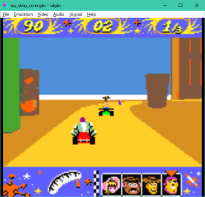sdgbc
 sdgbc copied to clipboard
sdgbc copied to clipboard
Emulator for the Game Boy Color with audio & other features. Prize winning final year B.Sc. project at the University of Leicester.
sdgbc
NOTE: this project is not actively maintained, though I do sometimes apply bugfixes due to dependency updates.
A software emulator for the Nintendo Game Boy Color written in C++ using SFML and wxWidgets. Available for Windows and Linux (tested using the MSVC and GCC compilers).



This emulator can run most Game Boy and Game Boy Color games from their ROM dump files to an acceptable level of accuracy, including those requiring MBC1, MBC2, MBC3 (with minimal RTC) and MBC5 (without Rumble) support.
sdgbc was developed as a final year BSc. computer science project at the University
of Leicester, UK.
A copy of the submitted dissertation and viva presentation slides can be
found in the docs directory.
Short Overview Video
Click on the image below to be taken a 1 minute overview video describing sdgbc:
Building
sdgbc is configured to be built using CMake (version 3.5 or above). The code relies on some C++14 features, and thus, requires a C++14 standard-compliant compiler.
The following instructions assume some familiarity with CMake. Running cmake-gui
or ccmake is recommended to easily follow these instructions:
Building for Windows
The following has been tested using CMake 3.5, MSVC 14, wxWidgets 3.0.1 and SFML 2.4.1:
- Launch CMake.
- Set the source code directory to the sdgbc repository root directory.
- Set the binary output directory to any directory you wish.
- Create a
PATHcache variable calledSFML_ROOT. Set it to root directory of your SFML installation. - Create a
PATHcache variable calledwxWidgets_ROOT_DIR. Set it to root directory of your wxWidgets installation. - Create a
PATHcache variable calledwxWidgets_LIB_DIR. Set it to thelib\vc140_dlldirectory of your wxWidgets installation. - Configure the project using the
Visual Studio 14 2015generator. - Generate the project file. A
sdgbc.slnVisual Studio solution file will be created inside of the specified binary output directory.
After opening the solution file in Visual Studio, press Ctrl+F5 to build and run the software (without debugging).
Building for Linux
The following has been tested using CMake 3.5, GCC 5.4, wxWidgets 3.0.1 and SFML
2.3.1 on X11:
(You may experience some X11 compatibility issues running the software with any
version of SFML greater than 2.3.1!)
- Launch CMake.
- Set the source code directory to the sdgbc repository root directory.
- Set the binary output directory to any directory you wish.
- Create a
PATHcache variable calledSFML_ROOT. Set it to root directory of your SFML installation. - Configure the project using the
Unix Makefilegenerator. - Generate the makefile. It will be created inside of the specified binary output directory.
Using a shell, change your current working directory to the binary output directory
and run make.
This can be done using sh or bash by running the following command:
cd BINARY_DIR_PATH && make
Running
The emulator can be ran in a GUI mode by simply opening the built sdgbc executable
file. The emulated joypad can be interacted with using the keyboard as follows:
| Joypad Key | Keyboard Key |
|---|---|
| D-pad Keys | Arrow Keys |
| B | Z |
| A | X |
| Start | Return |
| Select | Shift |

Additionally, a command-line interface for debugging the emulated CPU is
available for use. It can be accessed by passing the --cpu-cmd argument to
the program. A list of commands can be found by executing the help command.
Optionally, a path to a GB or GBC ROM file can be given via the command-line arguments for both modes:
-
sdgbc ROM_PATH(for the main GUI mode) -
sdgbc --cpu-cmd ROM_PATH(for the command-line CPU debugger mode)
License
The software is distributed using the MIT license as follows:
The MIT License (MIT)
Copyright (c) 2017-2018 Sean Dewar (seandewar @ Github)
Permission is hereby granted, free of charge, to any person obtaining a copy of
this software and associated documentation files (the "Software"), to deal in
the Software without restriction, including without limitation the rights to
use, copy, modify, merge, publish, distribute, sublicense, and/or sell copies of
the Software, and to permit persons to whom the Software is furnished to do so,
subject to the following conditions:
The above copyright notice and this permission notice shall be included in all
copies or substantial portions of the Software.
THE SOFTWARE IS PROVIDED "AS IS", WITHOUT WARRANTY OF ANY KIND, EXPRESS OR
IMPLIED, INCLUDING BUT NOT LIMITED TO THE WARRANTIES OF MERCHANTABILITY, FITNESS
FOR A PARTICULAR PURPOSE AND NONINFRINGEMENT. IN NO EVENT SHALL THE AUTHORS OR
COPYRIGHT HOLDERS BE LIABLE FOR ANY CLAIM, DAMAGES OR OTHER LIABILITY, WHETHER
IN AN ACTION OF CONTRACT, TORT OR OTHERWISE, ARISING FROM, OUT OF OR IN
CONNECTION WITH THE SOFTWARE OR THE USE OR OTHER DEALINGS IN THE SOFTWARE.
